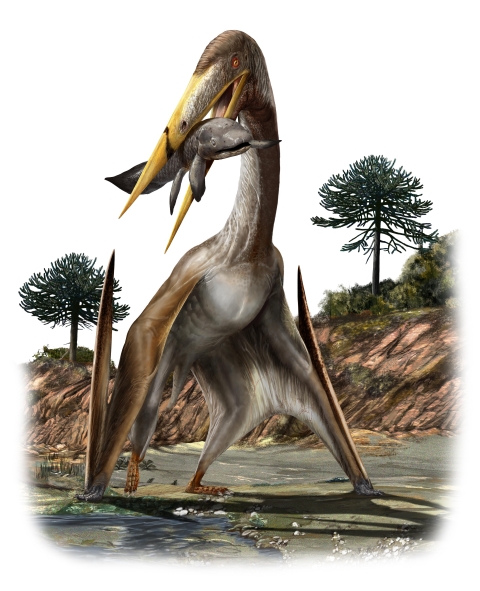

New CT scans have revealed a complex image of spoke-like structures – not unlike the spokes of a bicycle wheel.
14 April 2021
4 min read
Palaeontologists from the University of Portsmouth have discovered the incredible secret to the success of the flying pterosaur with a neck longer than a giraffe.
It had always been a matter of conjecture how gigantic flying azhdarchid pterosaurs managed to support their thin necks, yet still take off and fly whilst carrying heavy prey animals. New CT scans of intact remains discovered in Morocco have now solved the mystery and the findings were published in iScience today.
The scans reveal a complex image of spoke-like structures, arranged in a helix around a central tube inside the vertebra, not unlike the spokes of a bicycle wheel. This intricate design demonstrates how these flying reptiles had evolved to support massive heads that often measured longer than 1.5 metres. This ‘lightweight’ construction offered strength, without compromising the pterosaurs’ ability to fly.
Dave Martill, Professor of Palaeobiology, at the University of Portsmouth says: “It is unlike anything seen previously in a vertebra of any animal. The neural tube is placed centrally within the vertebra, and is connected to the external wall via a number of thin rod-like trabeculae, radially arranged like the spokes of a bicycle wheel, and helically arranged along the length of the vertebra. They even cross-over like the spokes of a bicycle wheel. Evolution shaped these creatures into awesome, breathtakingly efficient flyers.”
Researchers had originally set out to study the shape and movements of the neck, but took advantage of the offer of a CT scan to look inside.
The study of Moroccan material shows that we are still far from having found all the paleontological treasures of North Africa.
David Martill, Professor of Palaeobiology
The team of palaeontologists soon realised they needed expert engineering help to understand more about what they’d discovered. Analysis shows that as few as 50 of the ‘spokes’ in the pterosaur’s neck could lead to a 90 per cent increase in resistance to buckling. It’s thought the intricate construction could now help engineers develop new longer, thinner and stronger lightweight structures.
The Portsmouth based team are delighted with the new insights that the North African remains have delivered. Professor Martill said: “What was utterly remarkable was that the internal structure was perfectly preserved - so too was the bone cell structure when we examined it under the microscope. As soon as we saw the intricate pattern of radial trabeculae we realized there was something special going on.”
Pterosaurs first appeared in fossil records from the Triassic period, about 225 million years ago, but they disappeared at the end of the Cretaceous period, 66 million years ago along with their dinosaur cousins. Researchers say they now want to answer seemingly basic questions, including the flight abilities of a creature that has a wing span of up to 12 metres across.
